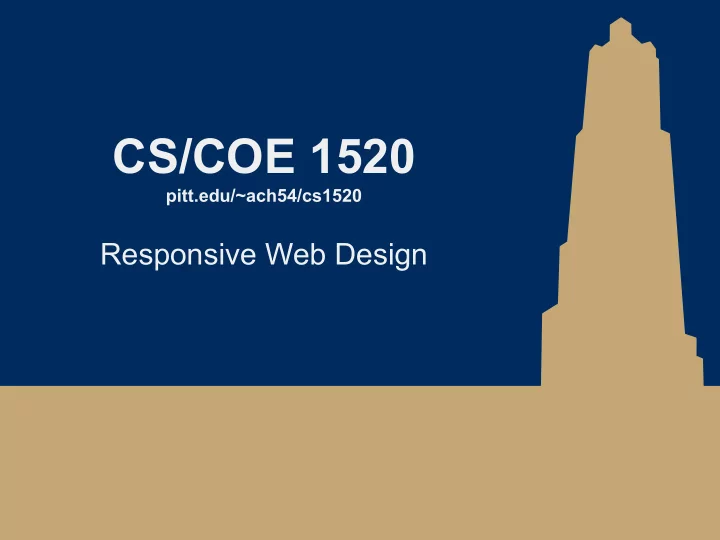

CS/COE 1520 pitt.edu/~ach54/cs1520 Responsive Web Design
Viewing a webpage in a small window 2
Viewing a webpage on a smartphone 3
Viewports Visual viewport Layout viewport 4
The idea behind responsive design ● "If you put water into a cup, it becomes the cup. You put water into a bottle and it becomes the bottle. You put it in a teapot, it becomes the teapot." - Bruce Lee 5
When a pixel is not a pixel... ● What happens when the user zooms in on their phone? ○ Need to display same portion of the page using more pixels ■ Should this scale up the size of the layout viewport? Pixel density of displays has begun to increase dramatically ● ○ How can we render the same page on both standard and HiDPI displays? ● In both cases, we'll consider an abstract "pixel" size when drawing the layout viewport, and map that to hardware pixels in the visual viewport ○ Layout viewport size is measured in "CSS pixels" 6
By default… ● Mobile browsers attempt to show the entire layout viewport in the browser window ○ The first tiny wikipedia page a few slides back ● How do we size the layout viewport appropriately? ○ We want to ensure that our webpage isn't rendered at the default layout viewport size and then "zoomed out" to fit 7
Meta viewport tags ● HTML <meta> tags are used to specify metadata that cannot be encoded in other tags ● With the development of their Retina displays, Apple started using the <meta name="viewport" … > tag to instruct the browser on sizing the layout viewport to properly display webpages formatted for mobile ● E.g.: <meta name="viewport" content="width=device-width, initial-scale=1"> 8
Great! But how to we build one page for all? ● CSS media queries ○ Allow the developer to tailor the site to present on a variety of output media without changing the content ○ Relevant for our case: ■ max-width: 600px ■ min-width: 500px ■ orientation: landscape ● orientation: portrait ○ Can be included in <link> tags to stylesheets, @import statements, or directly in css via @media tags 9
MDN's "pseudo-BNF" for media queries ● media_query_list: <media_query> [, <media_query> ]* media_query: [[only | not]? <media_type> [ and <expression> ]*] | <expression> [ and <expression> ]* expression: ( <media_feature> [: <value>]? ) media_type: all | aural | braille | handheld | print | projection | screen | tty | tv | embossed | speech media_feature: width | min-width | max-width | height | min-height | max-height | aspect-ratio | min-aspect-ratio | max-aspect-ratio | color | min-color | max-color | color-index | min-color-index | max-color-index | monochrome | min-monochrome | max-monochrome | resolution | min-resolution | max-resolution | scan | grid 10
Aside: BNF, or Backus–Naur form ● A way to describe a grammar ● Symbols are enclosed in < > ● Symbols are defined using ::= ● Options for defining a symbol are enumerated with | ● E.g.: ○ <integer> ::= <digit> | <digit> <integer> <digit> ::= "0" | "1" | "2" | "3" | "4" | "5" | "6" | "7" | "8" | "9" ○ <loop-statement> ::= <while-loop> | <for-loop> <while-loop> ::= "while (" <condition> ")" <statement> 11
US Postal address BNF Example <postal-address> ::= <name-part> <street-address> <zip-part> <name-part> ::= <personal-part> <last-name> <opt-suffix-part> <EOL> | <personal-part> <name-part> <personal-part> ::= <initial> "." | <first-name> <street-address> ::= <house-num> <street-name> <opt-apt-num> <EOL> <zip-part> ::= <town-name> "," <state-code> <ZIP-code> <EOL> <opt-suffix-part> ::= "Sr." | "Jr." | <roman-numeral> | "" <opt-apt-num> ::= <apt-num> | "" 12
BNF in BNF <syntax> ::= <rule> | <rule> <syntax> <rule> ::= <opt-whitespace> "<" <rule-name> ">" <opt-whitespace> "::=" <opt-whitespace> <expression> <line-end> <opt-whitespace> ::= " " <opt-whitespace> | "" <expression> ::= <list> | <list> <opt-whitespace> "|" <opt-whitespace> <expression> <line-end> ::= <opt-whitespace> <EOL> | <line-end> <line-end> <list> ::= <term> | <term> <opt-whitespace> <list> <term> ::= <literal> | "<" <rule-name> ">" <literal> ::= '"' <text1> '"' | "'" <text2> "'" <text1> ::= "" | <character1> <text1> <text2> ::= "" | <character2> <text2> <character> ::= <letter> | <digit> | <symbol> <letter> ::= "A" | "B" | "C" | "D" | "E" | "F" | "G" | "H" | "I" | "J" | "K" | "L" | "M" | "N" | "O" | "P" | "Q" | "R" | "S" | "T" | "U" | "V" | "W" | "X" | "Y" | "Z" | "a" | "b" | "c" | "d" | "e" | "f" | "g" | "h" | "i" | "j" | "k" | "l" | "m" | "n" | "o" | "p" | "q" | "r" | "s" | "t" | "u" | "v" | "w" | "x" | "y" | "z" <digit> ::= "0" | "1" | "2" | "3" | "4" | "5" | "6" | "7" | "8" | "9" <symbol> ::= "|" | " " | "!" | "#" | "$" | "%" | "&" | "(" | ")" | "*" | "+" | "," | "-" | "." | "/" | ":" | ";" | ">" | "=" | "<" | "?" | "@" | "[" | "\" | "]" | "^" | "_" | "`" | "{" | "}" | "~" <character1> ::= <character> | "'" <character2> ::= <character> | '"' <rule-name> ::= <letter> | <rule-name> <rule-char> <rule-char> ::= <letter> | <digit> | "-" 13
Common BNF extensions ● Optional items are enclosed in [ ] ● Items repeated 0 or more time are suffixed with * ● Items repeated 1 or more time are suffixed with + 14
Back to responsive design ● A couple of guidelines: ○ Use relative sizes ■ E.g., define the width of divs as a percentage of the page instead of a fixed pixel size ○ Set min and max widths for images ○ Change the layout as your page size changes ○ Start with the smallest needed size and define "breakpoints" as necessary 15
Recommend
More recommend